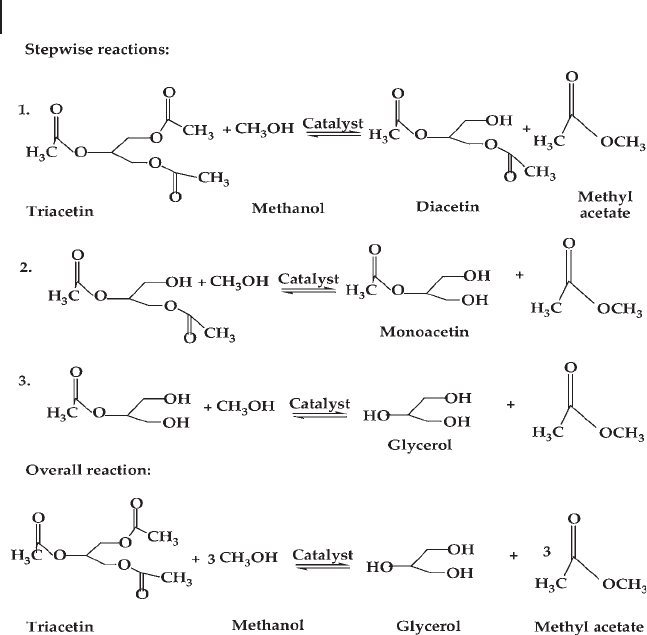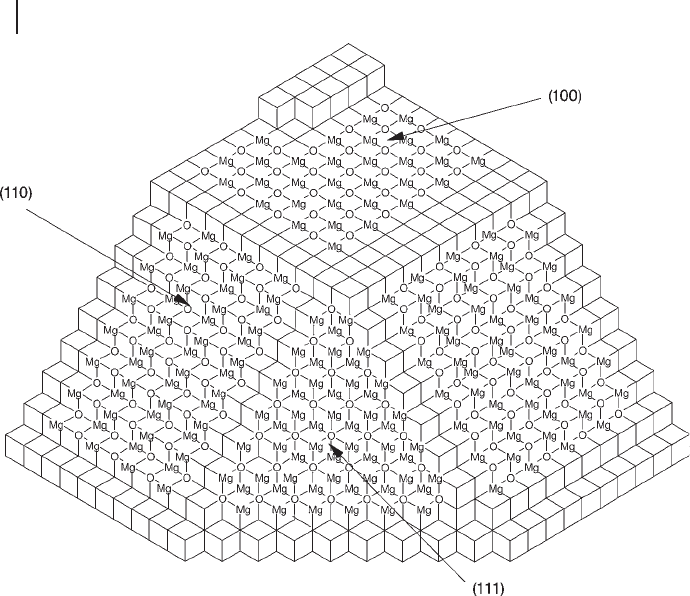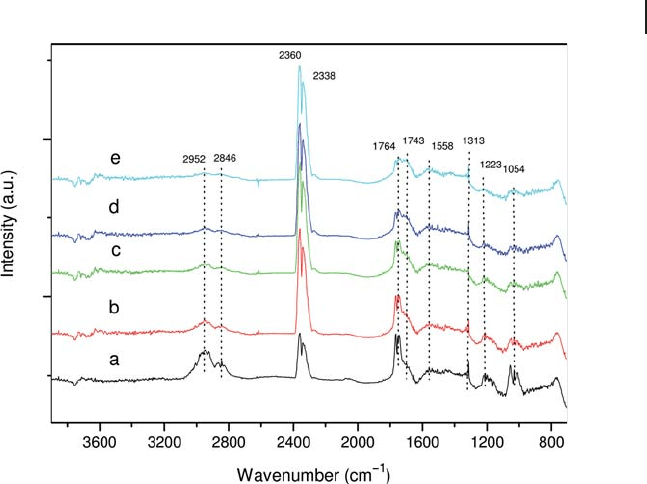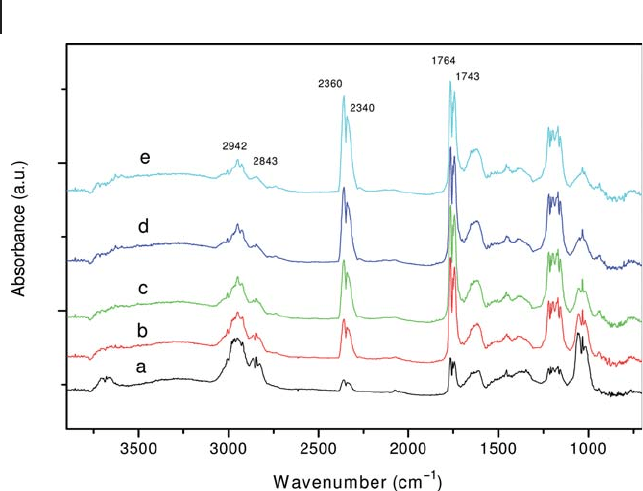Jackson S.D., Hargreaves J.S.J. Metal Oxide Catalysis
Подождите немного. Документ загружается.


16.3 Synthesis 639
tion of the rapidly condensed product particles on a cold substrate [63] . The fl ame
usually provides a high temperature (1200 – 3000 K), which promotes rapid gas -
phase chemical reactions [191] . Several types of fl ame reactors have been used in
research settings and have produced numerous types of nano - scale metal oxides
[63, 190 – 196] .
Chromium oxides have been synthesized by Lima and coworkers using solution
combustion [197] . The results suggest that glycine is a better complexing/combus-
tible agent for ammonium dichromate than urea. The addition of extra ammo-
nium nitrate to stoichiometric compositions improved the specifi c surface area
and reduced the crystallite size. The smallest crystallite size ( ≈ 20 nm) of Cr
2
O
3
was
obtained with glycine as fuel/complexant agent in fuel - lean mixtures. The highest
specifi c surface area (63 m
2
g
− 1
) was observed with urea in fuel - rich mixtures,
forming amorphous CrO
3
. Pratsinis and coworkers synthesized well structured
nanocrystals of ceria – zirconia mixed oxides with high temperature stability and
surface area. They sprayed cerium and zirconium precursors dissolved in carbox-
ylic acid into a methane – oxygen fl ame [198] . The mixed products had surface areas
from 60 – 90 m
2
g
− 1
. ZrO
2
powder was prepared by the gel combustion technique
using citric acid as a fuel and nitrate as an oxidant. Calcination at 600 ° C of the
dried powder, obtained after sluggish combustion of the citrate – nitrate gel, pro-
duced spherical nanocrystalline ZrO
2
with diameter about 10 nm [199] . Nanocrys-
talline LiMn
2
O
4
with cubic spinel structure has been prepared by combustion of
reaction mixtures containing Li(I) and Mn(II) nitrates that operate as oxidizers and
sucrose that acts as fuel [200] . Annealing at 700 ° C led to single - phase cubic spinels.
In these phases, the smallest average particle size (ca. 30 nm) corresponded to the
sample obtained with a hyperstoichiometric amount of fuel.
16.3.6
Others
There are numerous approaches to the synthesis of highly dispersed metal oxides
in addition to those discussed. These include some methods that have been less
commonly used to prepare metal oxides, such as vapor condensation methods,
spray pyrolysis and templated techniques.
16.3.6.1 Vapor Condensation Methods
Among the earliest methods for producing nanoparticles were gas condensation
techniques, which produce nanoparticles directly from a supersaturated vapor of
metals. These methods generally involve two steps: fi rst, a metallic nano - phase
powder is condensed under inert convection gas after a supersaturated vapor of
the metal is obtained inside a chamber. A high pressure of inert gas is usually
needed to achieve supersaturation, then the powder is oxidized by allowing oxygen
into the chamber. This post - oxidation is a critical step and it is very often necessary
for the process to be performed slowly. Because of the highly exothermic reaction,
particles heat up for short times (usually less than one second) to temperatures
as high as 1000 ° C, resulting in their agglomeration into large particles by rapid

640 16 Properties, Synthesis and Applications of Highly Dispersed Metal Oxide Catalysts
diffusion processes. A subsequent annealing process at higher temperature is
often required to complete the oxidation.
Gas condensation methods to prepare nanoparticles directly from supersatu-
rated vapor have many advantages over other techniques including versatility, the
ease of performance and analysis and the high purity of the products. These
methods can also be employed to produce fi lms and coatings. However, in spite
of their success, there are drawbacks in the high production cost because of low
yields and the diffi culty in scaling - up. Heating techniques have other disadvan-
tages, which include the possibility of reactions between the metal vapors and the
heating source materials. Furthermore, the operating temperature is limited by
the choice of the source material and, because of that, they cannot be used to make
a wide variety of materials.
16.3.6.2 Spray Pyrolysis
Another useful method for the synthesis of high - purity homogeneous oxide
powders is spray pyrolysis [201 – 206] . This technique has been known by several
other names, including solution aerosol thermolysis [203] , evaporative decomposi-
tion of solutions [204] , plasma vaporization of solutions [205] and aerosol decom-
position [206] . The starting materials in this process are chemical precursors,
usually appropriate salts, in solution, sol or suspension form. The process involves
the generation of aerosol droplets by nebulizing or atomizing the starting solution,
sol or suspension. The generated droplets undergo evaporation and solute con-
densation within the droplet, drying, thermolysis of the precipitate particle at
higher temperature to form microporous particles and, fi nally, sintering to form
dense particles.
Aqueous solutions are usually used because of their low cost, safety and the
availability of a wide range of water - soluble salts. Metal chloride and nitrate salts
are commonly used as precursors because of their high solubility. Precursors that
have low solubility or those that may induce impurities, such as acetates that lead
to carbon in the products, are less suitable [202, 204] . During the transformation
of the aerosol droplets into particles, different processes are involved, including
solvent evaporation, precipitation of dissolved precursor and thermolysis of pre-
cipitated particles. One advantage to this process is that all of these processes take
place in one step. Other advantages include the production of high - purity nano -
size particles, the homogeneity of the particles as a result of the homogeneity of
the original solution, the fact that each droplet/particle undergoes the same reac-
tion conditions and that no subsequent milling is necessary. Disadvantages of
spray pyrolysis include the large amounts of solvents necessary and the diffi culty
of scaling - up the production. The use of large amounts of non - aqueous solvents
increases production expenses because of the high cost of pure solvents and the
need for proper disposal.
16.3.6.3 Templated/Surface Derivatized Nanoparticles
In recent years, varieties of porous materials have been obtained by templated
techniques. Generally two types of templates have been reported in the literature,

soft templates (surfactants [207] ) and hard templates (porous solids such as carbon
or silica). In the case of hard templates, the formation of porous material takes
place in a confi ned space formed by the porosity of the template. Two types of
hard templates have been employed in template synthesis, active carbon [208] and
mesoporous silica materials [209 – 212] . Commercial active carbons were used as
templates to prepare different types of HSMO [213] and monodisperse and porous
spheres of oxides and phosphates [214] . However, the use of active carbons as
templates has certain limitations since, at the high treatment temperature employed
during the synthesis, infi ltrated salts and the carbon may react with each other,
destroying the intended material. Moreover, if the heat treatment is performed in
air, the carbon may be rapidly oxidized (ignition) even at relatively low temperature
owing to the catalytic effect of the infi ltrated salts. On the other hand, some metal-
lic salts may end up as metal instead of metal oxide as carbon is a good reducing
agent at high temperature under inert atmosphere.
16.4
Applications in Catalysis
As discussed in a previous section, metal oxides represent an important class of
materials exhibiting a broad range of properties from insulators to semiconductors
and conductors and have found applications as diverse as electronics, cosmetics
and catalysts. Metal oxides have been widely used in many valuable heterogeneous
catalytic reactions. Typical metal oxide - catalyzed reactions, including alkane oxida-
tion, biodiesel production, methanol adsorption and decomposition, destructive
adsorption of chlorocarbons and warfare agents, olefi n metathesis and the Claisen –
Schmidt condensation will be briefl y discussed as examples of metal oxide -
catalyzed reactions.
16.4.1
Oxygenation of Alkanes
Oxidation remains one of the principal paradigms for the activation of alkanes,
which are well known for their low reactivity, and is of interest both academically
and commercially. Among hydrocarbons, the oxidation of n - alkanes has attracted
much attention because they are abundant as feedstocks [215 – 218] . Catalytic oxida-
tion of alkanes has been explored using several oxidants and, for economic and
environmental reasons, oxidation processes used in bulk chemical industries pre-
dominantly involve the use of atmospheric oxygen as the primary oxidant. Their
success depends largely on the use of metal catalysts to promote both the rate of
reaction and the selectivity to partial oxidation products of organic substrates for
successful commercial processes [219, 220] . There have been a number of publica-
tions concerning alkane oxidation with molecular oxygen under mild conditions,
using transition metal oxide catalysts systems (summarized in Table 16.4 )
[221 – 232] .
16.4 Applications in Catalysis 641

642 16 Properties, Synthesis and Applications of Highly Dispersed Metal Oxide Catalysts
Table 16.4 Aerobic partial oxidation of alkanes by metal oxide catalysts.
Entry Alkane Catalyst T ( ° C) Oxidant/others Conversion (%) Selectivity (%) Products Ref.
1 ethane Mo - V - Nb - O 400 O
2
/He 22.7 47.8 ethene [221]
2 propane V
2
O
5
/SBA - 15 400 O
2
8 84 acrylic acid [222]
3 propane Co3O4 100 O
2
/Ar 0.8 100 propene [223]
4 propane V - P - O 400 air/H
2
O 23.0 48.1 acrylic acid [224]
5 propane V - P - O/TiO
2
- SiO
2
300 O
2
/H
2
O 21.8 61.2 acrylic acid [225]
6 propane V - P - O 300 O
2
/H
2
O 15 47.2 acrylic acid [225]
7 propane Mo - V - Sb - O 380 O
2
46 27 acrylic acid [226]
8 propane MoV
0.3
Te
0.23
P
0.15
O
n
500 O
2
46.6 8.1 acrylic acid [227]
9 n - butane V
2
O
5
/MgO 500 O
2
9.9 66.6 butene [228]
10 isobutane Mo - V - O 300 O
2
34.9 54.7 ethanoic acid [229]
1 1 n - pentane Mo - V - O 300 O
2
41.4 70.8 maleic anhydride [229]
12 cyclohexane V - P - O 65 H
2
O
2
/ acetonitrile 84 50/50 cyclohexanol/cyclohexanone [230]
1 3 n - heptane Co
3
O
4
450 O
2
/H
2
20.4 14.2 CO
2
[231]
1 4 n - hexane Co
3
O
4
450 O
2
/H
2
66.5 46.2 CO
2
[231]
1 5 n - heptane CeO
2
450 O
2
/H
2
7.5 9.0 CO
2
[231]
1 6 n - hexane CeO
2
450 O
2
/H
2
24.4 29.2 CO
2
[231]
1 7 n - hexane Ti - Si - O 50 H
2
O
2
7.0 (TON) 56 alcohols [232]
1 8 n - heptane Ti - Si - O 50 H
2
O
2
45 (TON) 80 alcohols [232]

The conversion of butane to maleic anhydride over a VPO catalyst remains the
only selective alkane oxidation technology that has achieved commercial operation.
The yields of maleic anhydride vary from 45 to 67%, with n - butane conversion at
∼ 90% and selectivity to maleic anhydride ranging from 65% to as high as 97%
(Scheme 16.1 ) [232, 245] .
The success of VPO catalysts in n - butane oxidation has stimulated great interest
in the selective oxidation of propane to acrylic acid [236, 237] . On the basis of the
excellent performance of VPO for converting n - butane to maleic anhydride, it is
reasonable to believe that they also have potential for converting propane to acrylic
acid effectively. Many studies are focused on the supported vanadium - catalyzed
partial oxidation of hydrocarbons and the supports can be SiO
2
[246, 247] , TiO
2
[248, 249] , Al
2
O
3
[250] and CeO
2
[251] . Most supported vanadium catalysts and
vanadium - based mixed - metal oxide s MMO [252] were been studied for the oxida-
tion of propane (Scheme 16.2 ). Although the history of the MMOs in propane to
acrylic acid oxidation is relatively short, they have shown excellent conversion
(80%) and selectivity (60%).
16.4.2
Biodiesel Production
The increasing concern over greenhouse gas emissions and the search for alterna-
tive renewable fuels has led to increased interest in fuels developed from renew-
able feedstocks. One such alternative fuel is biodiesel, which is recognized as a
“ green fuel ” produced from vegetable oil s ( VO ) and other feedstocks that primarily
contain triglyceride s ( TG ) and free fatty acid s ( FFA ) [253] . Biodiesel as a non -
petroleum - based fuel is normally synthesized through a chemical process called
transesterifi cation, whereby TGs react with a low molecular weight alcohol in the
presence of a catalyst to produce a complex mixture of fatty acid alkyl esters
(biodiesel) and glycerol. Transesterifi cation of TGs with low molecular weight
alcohols proceeds via three successive and reversible reactions. Figure 16.13 shows
the consecutive chemical reactions involved in the transesterifi cation of triacetin
with methanol. There are different processes that can be applied to the synthesis
of biodiesel: (1) base - catalyzed transesterifi cation [254] , (2) acid - catalyzed trans-
esterifi cation [255] , (3) integrated acid - catalyzed pre - esterifi cation of FFAs and
base - catalyzed transesterifi cation [256] , (4) enzyme - catalyzed transesterifi cation
Scheme 16.1
Scheme 16.2
16.4 Applications in Catalysis 643

644 16 Properties, Synthesis and Applications of Highly Dispersed Metal Oxide Catalysts
[257] , (5) hydrolysis and acid - catalyzed esterifi cation, (6) pyrolysis [258] and (7)
supercritical alcohol transesterifi cation [259] .
Industrially, homogeneous base catalysts (such as NaOH, KOH and NaOCH
3
)
are used. Base catalysis is preferred to the use of acid catalysts such as sulfuric
or sulfonic acids, given the corrosivity and lower activity of the latter. However,
the application of an alkaline catalyst in the transesterifi cation of waste cooking
oil is somewhat limited, because the FFA in waste cooking oil reacts with the
alkaline catalyst (KOH, NaOH) and forms soap. The soap formed during the
reaction prevents the glycerol separation, which drastically reduces the ester yield.
The water in waste cooking oil also affects the methyl ester yield by favoring a
saponifi cation reaction. Further, removal of the base catalyst after reaction is
problematic.
In order to circumvent these problems, the use of heterogeneous catalysts has
been explored. This approach eliminates the need for an aqueous quench and
largely eliminates the formation of metal salts, thereby simplifying downstream
separation steps; consequently, biodiesel production can be more readily per-
formed as a continuous process. Based on their ready availability, solid acid
Figure 16.13 The transesterifi cation reactions of triacetin and methanol.

catalysts such as zeolites, clays and ion exchange resins are attractive for this
purpose. Supported tungsten oxide catalysts have also received much attention
because of their acid properties and their ability to catalyze both esterifi cation and
transesterifi cation reactions, which play major roles in biodiesel production.
Furuta and coworkers [260] reported that soybean oil can be effi ciently converted
to methyl esters at a reaction temperature of 250 ° C using tungstated zirconia
alumina ( WZA ) calcined at 800 ° C. However, reaction rates are generally found to
be unacceptably low. Consequently, solid base catalysts have attracted attention.
Catalysts of this type include simple metal oxides such as MgO and CaO in sup-
ported or unsupported form, Zn – Al mixed oxides, cesium - exchanged zeolite X,
anion exchange resins, polymer - supported guanidines, Na/NaOH/Al
2
O
3
and K -
and Li - promoted oxides, prepared by impregnating the corresponding nitrate or
halide salt onto an oxidic carrier such as Al
2
O
3
, ZnO or CaO. Nano - crystalline
calcium oxide is an effi cient catalyst for the production of environmentally compat-
ible biodiesel fuel in high yields at room temperature using soybean oil (SBO) and
poultry fat as raw materials. An SBO : MeOH ratio of 1 : 27 is suitable for obtaining
high product yields: the conversion can reach 99%. Under the same conditions,
laboratory - grade CaO gave only 2% conversion in the case of SBO and there was
no observable reaction with poultry fat [261] .
16.4.3
Methanol Adsorption and Decomposition
One possible way to extend the application of metal oxides as catalysts is to tailor
their surface chemistry, as the catalytic process occurs only on solid surfaces and
surface structure typically controls activity and selectivity kinetically. Therefore, it
is desirable to obtain a high surface area of inexpensive metal oxides with a pref-
erentially grown outer surface to provide catalytically active sites, which requires
a combination of both surface science and catalysis. One case in point is the typical
rock salt structure of MgO. The traditional method of preparing MgO is the
thermal decomposition of either magnesium salts or magnesium hydroxides,
which results in inhomogeneity of morphology and crystallite size, with low
surface area. Many attempts were therefore made to tailor the texture and mor-
phology of MgO [262 – 267] . Most catalytic reactions reported to date are related to
the well known and conventional (100) surface [233, 268] ; however, the (111)
surface is more interesting as it is composed of alternating monolayers of anions
and cations so that a strong electrostatic fi eld perpendicular to the (111) surface
is created [234] . Such a surface has provided a prototype for the study of surface
structure and surface reactions, and has received great attention for theoretical
and experimental studies [235, 236] . Figure 16.14 shows the relation between the
exposed face and the coordination of MgO [237] .
Identifi cation of the active sites of the MgO surface is of crucial importance for
the understanding of the reaction mechanisms and the properties of MgO(111)
nanosheets. Methanol is a “ smart ” molecular probe that can provide fundamental
information about the number and nature of active surface sites [238] . Methanol
16.4 Applications in Catalysis 645

646 16 Properties, Synthesis and Applications of Highly Dispersed Metal Oxide Catalysts
decomposition has been found to be structure - sensitive, in that the selectivity
depends on the arrangement of the surface atoms. To satisfy ever - increasing
energy needs, all feasible alternative energy sources to our available oil and gas
resources must be considered. Methanol is an excellent fuel in its own right and
it can also be blended with gasoline, although it has half the volumetric energy
density relative to gasoline or diesel [239] . It is also used in the direct methanol
fuel cell ( DMFC ). The performance of liquid - feed methanol fuel cells is already
attractive for some applications and is approaching the levels required for electric
vehicle propulsion [240] . In this electrochemical cell, methanol is directly oxidized
with air to carbon dioxide and water to produce electricity, without the need to
fi rst generate hydrogen [241 – 244] . This greatly simplifi es the fuel - cell technology
and makes it accessible to a wide range of applications. For low - temperature fuel
cells, restricted by the extreme sensitivity of fuel - cell catalysts to CO poisoning, it
is very important to control the selectivity in this process [269] . Low - temperature
fuel cells require an external processor to produce H
2
and remove CO, which not
only reduces the effi ciency of the system but also increases its complexity and cost
[270] . The conventional Cu/ZnO - based methanol synthesis catalysts performed
Figure 16.14 The disposal of MgO on (001), (110) and (111) facets (from [240] ).

poorly for methanol decomposition and the catalysts suffered from rapid deactiva-
tion [271] . The activity and stability of the catalyst systems have been two major
challenges in the decomposition of methanol. MgO(111) nanosheets can decom-
pose methanol at low temperature and oxidize the surface C
=
O species formed
during methanol decomposition. The preparation of MgO(111) nanosheets is
simple and can be readily scaled - up. The large - scale application of MgO(111)
nanosheet catalysts without the necessity for transition metals for low - temperature
methanol decomposition may therefore be feasible.
The decomposition of methanol over MgO(111) nanosheets has been studied via
in situ IR spectroscopy, and both undissociated and dissociated methanol were
observed when MgO(111) nanosheets were exposed to methanol at 70 ° C (Figure
16.15 ) [273] . A large amount of CO
2
formed upon exposure to methanol at 70 ° C
(peaks at 2360 and 2341 cm
− 1
) and increased with time. The bands centered at
1558, 1313 and 1223 cm
− 1
can be attributed to chemisorbed CO
2
. A weak pair of
peaks at 1764 and 1743 cm
− 1
can be attributed to the C
=
O asymmetric stretching
of CO and formic acid [274, 275] , free CO stretching (2036, 2014 cm
− 1
) peaks were
also visible at 3 min. The intensity of the pair of peaks at 1764 and 1743 cm
− 1
decreased and the peaks at 2036 and 2014 cm
− 1
disappeared with time. This may
indicate that the C
=
O species formed were oxidized by the oxygen anions on the
surface of MgO(111) nanosheets. From the DRIFTS results we can see that metha-
nol was oxidized and decomposed to near completion on the surface of MgO(111)
Figure 16.15 DRIFT spectra of methanol adsorption and
reaction on MgO(111) nanosheets at 70 ° C after different
times: (a) 3 minutes, (b) 10 minutes, (c) 15 minutes,
(d) 20 minutes, (e) 25 minutes (from [273] ).
16.4 Applications in Catalysis 647

648 16 Properties, Synthesis and Applications of Highly Dispersed Metal Oxide Catalysts
nanosheets by 25 min, indicating that MgO(111) nanosheets are highly active for
methanol decomposition. In comparison with the spectra at room temperature,
the region of O
–
H stretching has no distinct change; indicating that methanol
interacts primarily with surface oxygen anions and oxygen defects but not hydroxyl
groups at 70 ° C. This suggests that the main active sites for methanol decomposi-
tion are oxygen defects and oxygen anions. First, methanol interacts with oxygen
defect sites to form methoxides, then the formed methoxides are oxidized by
surface oxygen anions. In order to better understand the surface structure of
MgO(111) nanosheets, methanol decomposition behavior and the relationship
between them, methanol adsorption on the surface of Commerial MgO (CM –
MgO) at 70 ° C under high vacuum was studied for comparison. The spectra are
shown in Figure 16.16 . The bands of CO
2
at 2360 and 2341 cm
− 1
increase and the
bands of C
–
H stretching between 2800 and 3100 cm
− 1
decrease in intensity with
time, indicating that methanol decomposition continues over time. Compared to
the spectra in Figure 16.15 e, the intensity of the bands between 2800 and 3100 cm
− 1
in Figure 16.16 e are much stronger. This suggests that the methanol conversion
is signifi cantly lower and the activity of CM - MgO is lower than that of MgO(111)
nanosheets. Comparison of the peaks at 1764 and 1743 cm
− 1
in Figures 16.15 and
16.16 , which have been attributed to surface C
=
O species, shows that the pair of
peaks in Figure 16.15 are weak and decrease in intensity with time, indicating that
the rate of formation of the surface C
=
O species is lower than the rate of further
Figure 16.16 DRIFT spectra of methanol adsorption and
reaction on CM - MgO at 70 ° C after different times: (a) 3
minutes, (b) 10 minutes, (c) 15 minutes, (d) 20 minutes and
(e) 25 minutes (from [273] ).
